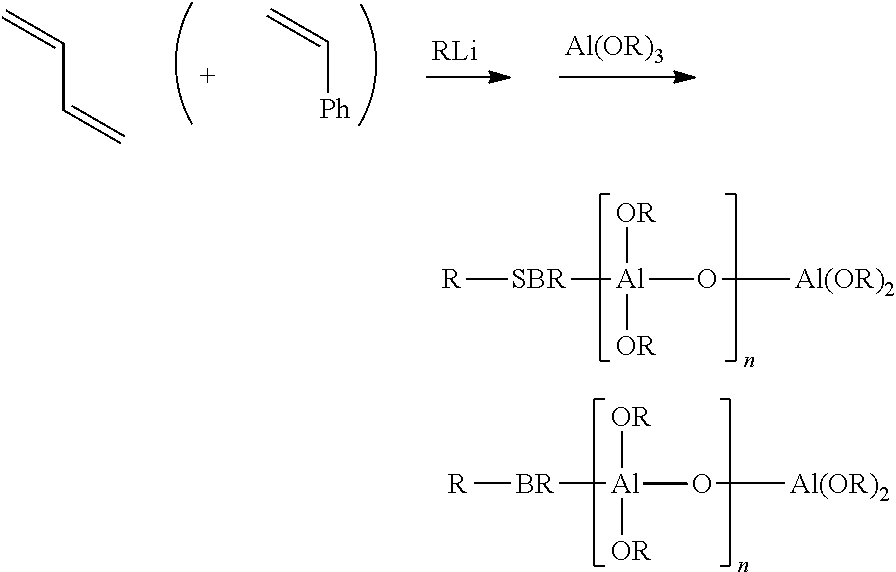Method of manufacturing terminal-modified polymer
a technology of terminal modification and polymer, which is applied in the field of terminal modification polymer manufacturing, can solve the problems of difficult introduction of acid anhydride group, low dispersibility of silica compounded into rubber composition, and difficulty in fully obtaining the effect of silica, so as to reduce rolling resistance and stability on wet roads, the effect of improving the dispersibility of silica compounded into the rubber composition
- Summary
- Abstract
- Description
- Claims
- Application Information
AI Technical Summary
Benefits of technology
Problems solved by technology
Method used
Image
Examples
example 1
[0045]To a 100 ml two-necked flask,[0046]cyclohexane (Kanto Chemical Co., Inc.) 7 ml[0047]2,2-ditetrahydrofurylpropane 0.248 g (1.35 mmol)[0048](Tokyo Chemical Industry Co., Ltd.)[0049]n-hexane solution of n-BuLi 2 ml (3.30 mmol)[0050](Kanto Chemical Co., Inc.; concentration: 1.65 mol / L)
were charged under the conditions of room temperature, and to the resulting solution,[0051]styrene (the same manufacturer as above) 5.90 g (56.6 mmol)
was added dropwise at 0° C., and stirred for 3 hours. Subsequently, a suspension of 1.35 g (6.61 mmol) of triisopropoxy aluminum (the same manufacturer as above) in 10 ml tetrahydrofuran was added to terminate the polymerization reaction.
[0052]The obtained reaction mixture was filtered using a filter paper, volatile components were distilled off from the filtrate, and the residue was dissolved in 30 ml of tetrahydrofuran. Then the solution was added dropwise to 200 ml of methanol to separate a methanol soluble component and a methanol insoluble componen...
example 2
[0068]2.24 g (yield: 85%) of a white viscous liquid terminal-modified polybutadiene was obtained as in Example 1 except that the amounts of 2,2-ditetrahydrofurylpropane and triisopropoxy aluminum were changed to 0.316 g (1.72 mmol) and 1.61 g (7.88 mmol), respectively, and 17.6 g (48.8 mmol) of 15 wt % n-hexane solution of 1,3-butadiene (Aldrich) was used instead of styrene.[0069]Mn: 1880[0070]PDI: 1.1[0071]Rf: 0.82[0072]1H-NMR (CDCl3, 20° C.): δ=5.9 to 5.7 (br)[0073]5.6 to 5.2 (br)[0074]5.1 to 4.8 (br)[0075]3.9 to 3.7 (br)[0076]2.3 to 1.7 (br)[0077]1.6 to 1.0 (br)[0078]0.8 to 0.7 (br)
example 3
[0079]3.90 g (yield: 91%) of a white viscous liquid terminal-modified styrene-butadiene copolymer was obtained as in Example 1 except that the amounts of 2,2-ditetrahydrofurylpropane and triisopropoxy aluminum were changed to 0.331 g (1.80 mmol) and 1.60 g (7.83 mmol), respectively, and a mixture of 11.4 g (31.6 mmol) of 15 wt % n-hexane solution of 1,3-butadiene and 2.58 g (24.8 mmol) of styrene was used instead of styrene alone.[0080]Mn: 2920[0081]PDI: 1.1[0082]Rf: 0.83[0083]1H-NMR (CDCl3, 20° C.): δ=7.4 to 6.9 (br)[0084]6.9 to 6.2 (br)[0085]5.8 to 5.0 (br)[0086]5.0 to 4.4 (br)[0087]3.8 to 3.6 (br)[0088]2.6 to 0.9 (br)[0089]0.9 to 0.7 (br)
PUM
| Property | Measurement | Unit |
|---|---|---|
| rolling resistance | aaaaa | aaaaa |
| stability | aaaaa | aaaaa |
Abstract
Description
Claims
Application Information
 Login to View More
Login to View More - R&D
- Intellectual Property
- Life Sciences
- Materials
- Tech Scout
- Unparalleled Data Quality
- Higher Quality Content
- 60% Fewer Hallucinations
Browse by: Latest US Patents, China's latest patents, Technical Efficacy Thesaurus, Application Domain, Technology Topic, Popular Technical Reports.
© 2025 PatSnap. All rights reserved.Legal|Privacy policy|Modern Slavery Act Transparency Statement|Sitemap|About US| Contact US: help@patsnap.com

